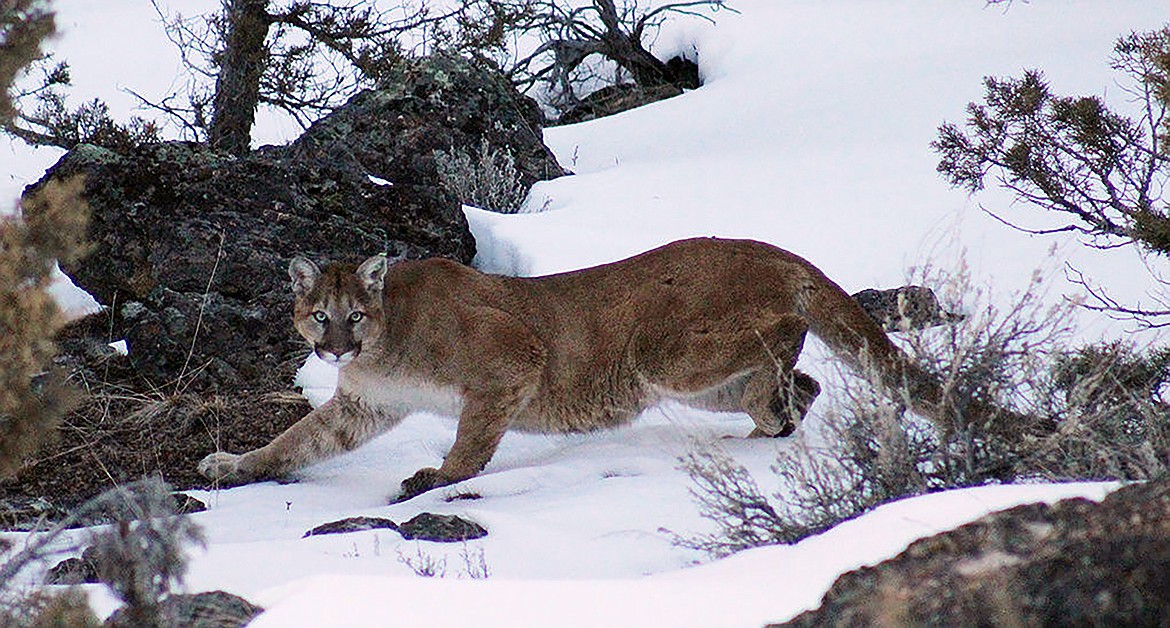Sighting a mountain lion is a rare and unexpected event
The mountain lion (puma concolor), also known as the cougar, puma, deer tiger, and panther is the most widely distributed cat in the Americas. Mountain lions require a lot of room — only a few cats can survive in a 30-square-mile range. They are solitary and shy animals, seldom seen by humans.
Sighting a wild mountain lion is a rare and unexpected event. Thus far I have been privileged to see four mountain lions in Boundary County, but unfortunately, I haven’t taken a picture of one because they have eluded me. It is an eerie feeling to walk in an area where mountain lion tracks are evident or where you have just seen this elusive cat. This is an experience that will certainly raise the hair on the back of your neck. I have heard the scream of a mountain lion twice at night and the scream of a mountain lion is certainly unforgettable, once heard it will remain in your memory forever.
An adult male, called a tom, mountain lion can weigh up to 180 pounds and measure up to 8 feet in length from nose to tail. Mature females, called queens, will measure 7 feet in length from tail to nose and weigh as much as 96 pounds. Mountain lions mark out a home area by urinating and defecating on the ground and pulling the material along with leaves into a scrape. By doing this the mountain lion leaves a “sign post” about its territory. A typical male is 50-150 square miles in size while a female will have a territory of less than 50 square miles.
With the exception of breeding mountain lions, they are solitary animals. Queens become sexually mature when they are about 2 1/2 years old. The young, called kittens or cubs, can be born at any time of the year after a gestation period of 84 to 106 days. Queens can have litters of up to 4 kittens but usually only one two will survive. The kittens are born with spots and will learn about life as a mountain lion from their mother until they are about a year and a half old. Then they are abandoned by the mother and forced to find their own territory and means of survival.
The mountain lion used to be found all over the United States, but now is primarily seen in the western U.S. An endangered subspecies of mountain lion also remains in Florida. These felines are comfortable in many different habitats and, aside from humans, have the widest geographic range of any land mammal in the Western Hemisphere. Mountain lions can be seen in all habitats of the Rocky Mountains. In North Idaho they rely on deer and elk as prey but the cougar is an opportunistic feeder and will just as easily eat mice, rabbits, beaver, grouse, coyotes, raccoons, porcupine and occasionally livestock.
The predatory behavior of a mountain ;lion is much like a domestic cat. The mountain lion will generally conceal itself and relies on a surprise attack to gain the upper-hand in a struggle between life and death. A twitching tail and upright ears will be seen on a mountain lion that is stalking its prey. An agitated mountain lion will lay back its ears and snarl loudly. The size to strength ratio of a mountain lion is incredible. It is able to take down animals many times its own size. A 400-pound animal is no match against a mountain lion. When it kills an elk the mountain lion will land on its neck and pull the elk's head back with its front legs with a force strong enough to break the neck. They typically will hide or bury the carcass and feed on it for several days before moving on for the next meal.
Do not approach a mountain lion, most mountain lions will try to avoid confrontation, so give them a way to escape.
Enjoy Boundary County and its amazing wildlife.

